Au-Co Alloy Nanoparticles Supported on ZrO2 as an Efficient Photocatalyst for the Deoxygenation of Styrene Oxide
Abstract
1. Introduction
2. Materials and Methods
2.1. Materials
2.2. Catalyst Preparation
2.3. Catalyst Characterisation
2.4. The Procedure for the Photocatalytic Reaction for the Deoxygenation of Styrene Oxide
3. Results and Discussion
3.1. Catalyst Characterisation
3.2. Catalytic Activity Towards Deoxygenation of Epoxides
3.2.1. Selective Conversion of Styrene Oxide to Styrene with Au/ZrO2
3.2.2. Deoxygenation of Epoxides with Au-Co Alloy-Loaded ZrO2 Nanoparticles
4. Conclusions
Supplementary Materials
Author Contributions
Funding
Data Availability Statement
Acknowledgments
Conflicts of Interest
Abbreviations
| XRD | X-ray Diffraction |
| XPS | X-ray Photoelectron Spectroscopy |
| EPR | Electron Paramagnetic Resonance |
| NPs | Nanoparticles |
| SERS | Surface-Enhanced Raman Spectroscopy |
References
- Shiraishi, Y.; Hirakawa, H.; Togawa, Y.; Hirai, T. Noble-Metal-Free Deoxygenation of Epoxides: Titanium Dioxide as a Photocatalytically Regenerable Electron-Transfer Catalyst. ACS Catal. 2014, 4, 1642–1649. [Google Scholar] [CrossRef]
- Mitsudome, T.; Kaneda, K. Gold nanoparticle catalysts for selective hydrogenations. Green Chem. 2013, 15, 2636–2654. [Google Scholar] [CrossRef]
- Mori, T.; Takeuchi, Y.; Hojo, M. Nickel-catalyzed deoxygenation of oxiranes: Conversion of epoxides to alkenes. Tetrahedron Lett. 2020, 61, 151518. [Google Scholar] [CrossRef]
- Batra, M.S.; Dwivedi, R.; Prasad, R. Recent Developments in Heterogeneous Catalyzed Epoxidation of Styrene to Styrene Oxide. Chem. Sel. 2019, 4, 11636–11673. [Google Scholar] [CrossRef]
- Noujima, A.; Mitsudome, T.; Mizugaki, T.; Jitsukawa, K.; Kaneda, K. Selective deoxygenation of epoxides to alkenes with molecular hydrogen using a hydrotalcite-supported gold catalyst: A concerted effect between gold nanoparticles and basic sites on a support. Angew. Chem. Int. Ed. Engl. 2011, 50, 2986–2989. [Google Scholar] [CrossRef]
- Sarina, S.; Waclawik, E.R.; Zhu, H. Photocatalysis on supported gold and silver nanoparticles under ultraviolet and visible light irradiation. Green Chem. 2013, 15, 1814–1833. [Google Scholar] [CrossRef]
- Ameta, R.; Solanki, M.S.; Benjamin, S.; Ameta, S.C. Photocatalysis. In Advanced Oxidation Processes for Waste Water Treatment; Academic Press: Cambridge, MA, USA, 2018; pp. 135–175. [Google Scholar]
- Zhang, Y.; He, S.; Guo, W.; Hu, Y.; Huang, J.; Mulcahy, J.R.; Wei, W.D. Surface-plasmon-driven hot electron photochemistry. Chem. Rev. 2017, 118, 2927–2954. [Google Scholar] [CrossRef]
- Sarina, S.; Zhu, H.; Jaatinen, E.; Xiao, Q.; Liu, H.; Jia, J.; Chen, C.; Zhao, J. Enhancing catalytic performance of palladium in gold and palladium alloy nanoparticles for organic synthesis reactions through visible light irradiation at ambient temperatures. J. Am. Chem. Soc. 2013, 135, 5793–5801. [Google Scholar] [CrossRef]
- Ahmed, W.; Iqbal, J. Co doped ZrO2 nanoparticles: An efficient visible light triggered photocatalyst with enhanced structural, optical and dielectric characteristics. Ceram. Int. 2020, 46, 25833–25844. [Google Scholar] [CrossRef]
- Alvarez, M.; López, T.; Odriozola, J.A.; Centeno, M.A.; Domínguez, M.I.; Montes, M.; Quintana, P.; Aguilar, D.H.; González, R.D. 2,4-Dichlorophenoxyacetic acid (2,4-D) photodegradation using an Mn+/ZrO2 photocatalyst: XPS, UV–vis, XRD characterization. Appl. Catal. B Environ. 2007, 73, 34–41. [Google Scholar] [CrossRef]
- Li, Y.; Ji, H.; Chen, C.; Ma, W.; Zhao, J. Concerted two-electron transfer and high selectivity of TiO2 in photocatalyzed deoxygenation of epoxides. Angew. Chem. Int. Ed. Engl. 2013, 52, 12636–12640. [Google Scholar] [CrossRef] [PubMed]
- Ke, X.; Zhang, X.; Zhao, J.; Sarina, S.; Barry, J.; Zhu, H. Selective reductions using visible light photocatalysts of supported gold nanoparticles. Green. Chem. 2013, 15, 236–244. [Google Scholar] [CrossRef]
- Mitsudome, T.; Noujima, A.; Mikami, Y.; Mizugaki, T.; Jitsukawa, K.; Kaneda, K. Supported gold and silver nanoparticles for catalytic deoxygenation of epoxides into alkenes. Angew. Chem. Int. Ed. Engl. 2010, 49, 5545–5548. [Google Scholar] [CrossRef] [PubMed]
- Märki, H.P.; Crameri, Y.; Eigenmann, R.; Krasso, A.; Ramuz, H.; Bernauer, K.; Goodman, M.; Melmon, K.L. Optically pure isoproterenol analogues with side chains containing an amide bond: Synthesis and biological properties. Helv. Chim. Acta 1988, 71, 320–336. [Google Scholar] [CrossRef]
- Bradshaw, J.S.; Jolley, S.T.; Izatt, R.M. Preparation of chiral diphenyl substituted polyether-diester compounds. J. Org. Chem. 1982, 47, 1229–1232. [Google Scholar] [CrossRef]
- Tian, X.; Zheng, G.W.; Li, C.X.; Wang, Z.L.; Xu, J.H. Enantioselective production of (S)-1-phenyl-1,2-ethanediol from dicarboxyesters by recombinant Bacillus subtilis esterase. J. Mol. Catal. B Enzym. 2011, 73, 80–84. [Google Scholar] [CrossRef]
- Liu, X.; Wang, A.; Zhang, T.; Su, D.-S.; Mou, C.-Y. Au–Cu alloy nanoparticles supported on silica gel as catalyst for CO oxidation: Effects of Au/Cu ratios. Catal. Today 2011, 160, 103–108. [Google Scholar] [CrossRef]
- Azam, A.; Ahmed, A.S.; Chaman, M.; Naqvi, A. Investigation of electrical properties of Mn doped tin oxide nanoparticles using impedance spectroscopy. J. Appl. Phys. 2010, 108, 094329. [Google Scholar] [CrossRef]
- Yang, L.; Li, G.; Hu, W.; Zhao, M.; Sun, L.; Zheng, J.; Yan, T.; Li, L. Control Over the Crystallinity and Defect Chemistry of YVO4 Nanocrystals for Optimum Photocatalytic Property; Wiley Online Library: Montreal, QC, Canada, 2011. [Google Scholar]
- Suwanboon, S.; Amornpitoksuk, P.; Sukolrat, A. Dependence of optical properties on doping metal, crystallite size and defect concentration of M-doped ZnO nanopowders (M = Al, Mg, Ti). Ceram. Int. 2011, 37, 1359–1365. [Google Scholar] [CrossRef]
- Azam, A.; Ahmed, A.S.; Habib, S.S.; Naqvi, A.H. Effect of Mn doping on the structural and optical properties of SnO2 nanoparticles. J. Alloys Compd. 2012, 523, 83–87. [Google Scholar] [CrossRef]
- Reddy, C.V.; Reddy, I.N.; Akkinepally, B.; Harish, V.V.N.; Reddy, K.R.; Jaesool, S. Mn-doped ZrO2 nanoparticles prepared by a template-free method for electrochemical energy storage and abatement of dye degradation. Ceram. Int. 2019, 45, 15298–15306. [Google Scholar] [CrossRef]
- Peiris, E.; Sarina, S.; Waclawik, E.R.; Ayoko, G.A.; Han, P.; Jia, J.; Zhu, H.Y. Plasmonic Switching of the Reaction Pathway: Visible-Light Irradiation Varies the Reactant Concentration at the Solid-Solution Interface of a Gold-Cobalt Catalyst. Angew. Chem. Int. Ed. Engl. 2019, 58, 12032–12036. [Google Scholar] [CrossRef] [PubMed]
- Jasrotia, R.; Verma, A.; Verma, R.; Godara, S.K.; Ahmed, J.; Mehtab, A.; Ahmad, T.; Puri, P.; Kalia, S. Photocatalytic degradation of malachite green pollutant using novel dysprosium modified Zn–Mg photocatalysts for wastewater remediation. Ceram. Int. 2022, 48, 29111–29120. [Google Scholar] [CrossRef]
- Bindu, P.; Thomas, S. Estimation of lattice strain in ZnO nanoparticles: X-ray peak profile analysis. J. Theor. Appl. Phys. 2014, 8, 123–134. [Google Scholar] [CrossRef]
- Nabika, H.; Mizuhata, M.; Kajinami, A.; Deki, S.; Akamatsu, K. Preparation and characterization of Au/Co nano-alloys. J. Electroanal. Chem. 2003, 559, 99–102. [Google Scholar] [CrossRef]
- Weerathunga, H.; Brock, A.J.; Sarina, S.; Deshan, A.D.K.; Zhu, H.-Y.; Waclawik, E.R. AuCu/ZnO heterogeneous photocatalysts: Photodeposited AuCu alloy effect on product selectivity in alkene epoxidation. J. Photochem. Photobiol. A Chem. 2022, 426, 113732. [Google Scholar] [CrossRef]
- Sabat, K.C. Formation of CuCo alloy from their oxide mixtures through reduction by low-temperature hydrogen plasma. Plasma Chem. Plasma Process. 2019, 39, 1071–1086. [Google Scholar] [CrossRef]
- Rajashekhar, H.; Vrushabendrakumar, D.; Alam, K.M.; Kumar, N.; Garcia, J.C.; Shankar, K. Stand-Alone Sponge-Shaped Mesoporous AuPt Alloy Nanosponges as Visible Photocatalyst for the Selective Reduction of CO2 to CO. ACS Appl. Nano Mater. 2025, 8, 1786–1795. [Google Scholar] [CrossRef]
- Gionco, C.; Paganini, M.C.; Chiesa, M.; Maurelli, S.; Livraghi, S.; Giamello, E. Cerium doped zirconium dioxide as a potential new photocatalytic material. The role of the preparation method on the properties of the material. Appl. Catal. A Gen. 2015, 504, 338–343. [Google Scholar] [CrossRef]
- Klein, J.; Kampermann, L.; Mockenhaupt, B.; Behrens, M.; Strunk, J.; Bacher, G. Limitations of the Tauc Plot Method. Adv. Funct. Mater. 2023, 33, 2304523. [Google Scholar] [CrossRef]
- Makula, P.; Pacia, M.; Macyk, W. How To Correctly Determine the Band Gap Energy of Modified Semiconductor Photocatalysts Based on UV-Vis Spectra. J. Phys. Chem. Lett. 2018, 9, 6814–6817. [Google Scholar] [CrossRef] [PubMed]
- Guadagnini, A.; Agnoli, S.; Badocco, D.; Pastore, P.; Pilot, R.; Ravelle-Chapuis, R.; van Raap, M.B.F.; Amendola, V. Kinetically Stable Nonequilibrium Gold-Cobalt Alloy Nanoparticles with Magnetic and Plasmonic Properties Obtained by Laser Ablation in Liquid. ChemPhysChem 2021, 22, 657–664. [Google Scholar] [CrossRef] [PubMed]
- Chimentão, R.J.; Cota, I.; Dafinov, A.; Medina, F.; Sueiras, J.E.; de la Fuente, J.L.G.; Fierro, J.L.G.; Cesteros, Y.; Salagre, P. Synthesis of silver-gold alloy nanoparticles by a phase-transfer system. J. Mater. Res. 2006, 21, 105–111. [Google Scholar] [CrossRef]
- Khassin, A.A.; Yurieva, T.M.; Kaichev, V.V.; Bukhtiyarov, V.I.; Budneva, A.A.; Paukshtis, E.A.; Parmon, V.N. Metal–support interactions in cobalt-aluminum co-precipitated catalysts: XPS and CO adsorption studies. J. Mol. Catal. A Chem. 2001, 175, 189–204. [Google Scholar] [CrossRef]
- Zhou, Y.; Wang, X.; Huang, X.; Deng, H.; Hu, Y. Construction of a gold-cobalt alloy catalyst to enhance the green reduction of carbon dioxide. J. CO2 Util. 2022, 65, 102245. [Google Scholar] [CrossRef]
- Anku, W.W.; Oppong, S.O.-B.; Shukla, S.K.; Agorku, E.S.; Govender, P.P. Cobalt doped ZrO2 decorated multiwalled carbon nanotube: A promising nanocatalyst for photodegradation of indigo carmine and eosin Y dyes. Prog. Nat. Sci. Mater. Int. 2016, 26, 354–361. [Google Scholar] [CrossRef]
- Feinberg, A.; Perry, C. Structural disorder and phase transitions in ZrO2-Y2O3 system. J. Phys. Chem. Solids 1981, 42, 513–518. [Google Scholar] [CrossRef]
- Yi, M.; Zhang, Y.; Xu, J.; Deng, D.; Mao, Z.; Meng, X.; Shi, X.; Zhao, B. Surface-Enhanced Raman Scattering Activity of ZrO(2) Nanoparticles: Effect of Tetragonal and Monoclinic Phases. Nanomaterials 2021, 11, 2162. [Google Scholar] [CrossRef]
- Keresztury, G.; Chalmers, J.; Griffith, P. Raman spectroscopy: Theory. Handb. Vib. Spectrosc. 2002, 1, 71–87. [Google Scholar]
- Rohini, B.; Kavyashree, D.; Lavanya, D.; Sunitha, D.; Nagabhushana, H. Structural, optical, and dielectric characteristics of Fe doped ZrO2 nanoparticles for multifunctional applications. Phys. Lett. A 2024, 525, 129855. [Google Scholar] [CrossRef]
- Choi, H.C.; Jung, Y.M.; Kim, S.B. Size effects in the Raman spectra of TiO2 nanoparticles. Vib. Spectrosc. 2005, 37, 33–38. [Google Scholar] [CrossRef]
- Palkar, V.; Purandare, S.; Ayyub, P.; Pinto, R. Si induced size effects in ferroelectric PbTiO3. J. Appl. Phys. 2000, 87, 462–466. [Google Scholar] [CrossRef]
- Zhu, H.; Ke, X.; Yang, X.; Sarina, S.; Liu, H. Reduction of nitroaromatic compounds on supported gold nanoparticles by visible and ultraviolet light. Angew. Chem. Int. Ed. Engl. 2010, 49, 9657–9661. [Google Scholar] [CrossRef]
- Cheng, C.; Zhu, B.; Cheng, B.; Macyk, W.; Wang, L.; Yu, J. Catalytic conversion of styrene to benzaldehyde over S-scheme photocatalysts by singlet oxygen. ACS Catal. 2022, 13, 459–468. [Google Scholar] [CrossRef]
- Liu, H.; Li, M.; Dao, T.D.; Liu, Y.; Zhou, W.; Liu, L.; Meng, X.; Nagao, T.; Ye, J. Design of PdAu alloy plasmonic nanoparticles for improved catalytic performance in CO2 reduction with visible light irradiation. Nano Energy 2016, 26, 398–404. [Google Scholar] [CrossRef]
- Xiao, Q.; Sarina, S.; Jaatinen, E.; Jia, J.; Arnold, D.P.; Liu, H.; Zhu, H. Efficient photocatalytic Suzuki cross-coupling reactions on Au–Pd alloy nanoparticles under visible light irradiation. Green Chem. 2014, 16, 4272–4285. [Google Scholar] [CrossRef]
- Peiris, S.; Sarina, S.; Han, C.; Xiao, Q.; Zhu, H.Y. Silver and palladium alloy nanoparticle catalysts: Reductive coupling of nitrobenzene through light irradiation. Dalton Trans. 2017, 46, 10665–10672. [Google Scholar] [CrossRef]
- Xiao, Q.; Sarina, S.; Waclawik, E.R.; Jia, J.; Chang, J.; Riches, J.D.; Wu, H.; Zheng, Z.; Zhu, H. Alloying Gold with Copper Makes for a Highly Selective Visible-Light Photocatalyst for the Reduction of Nitroaromatics to Anilines. ACS Catal. 2016, 6, 1744–1753. [Google Scholar] [CrossRef]
- Moskovits, M. Surface-enhanced spectroscopy. Rev. Mod. Phys. 1985, 57, 783. [Google Scholar] [CrossRef]
- Sears, W.; Hunt, J.; Stevens, J. Raman scattering from polymerizing styrene. I. Vibrational mode analysis. J. Chem. Phys. 1981, 75, 1589–1598. [Google Scholar] [CrossRef]
- Krishnan, K.; Krishnan, R. Raman and infrared spectra of ethylene glycol. In Proceedings of the Indian Academy of Sciences-Section A; Springer: Berlin/Heidelberg, Germany, 1996; Volume 64, pp. 111–122. [Google Scholar]
- Banwell, M.G.; Jones, M.T.; Reekie, T.A.; Schwartz, B.D.; Tan, S.H.; White, L.V. RANEY® cobalt–an underutilised reagent for the selective cleavage of C–X and N–O bonds. Org. Biomol. Chem. 2014, 12, 7433–7444. [Google Scholar] [CrossRef] [PubMed]
- Johnstone, R.A.; Wilby, A.H.; Entwistle, I.D. Heterogeneous catalytic transfer hydrogenation and its relation to other methods for reduction of organic compounds. Chem. Rev. 1985, 85, 129–170. [Google Scholar] [CrossRef]
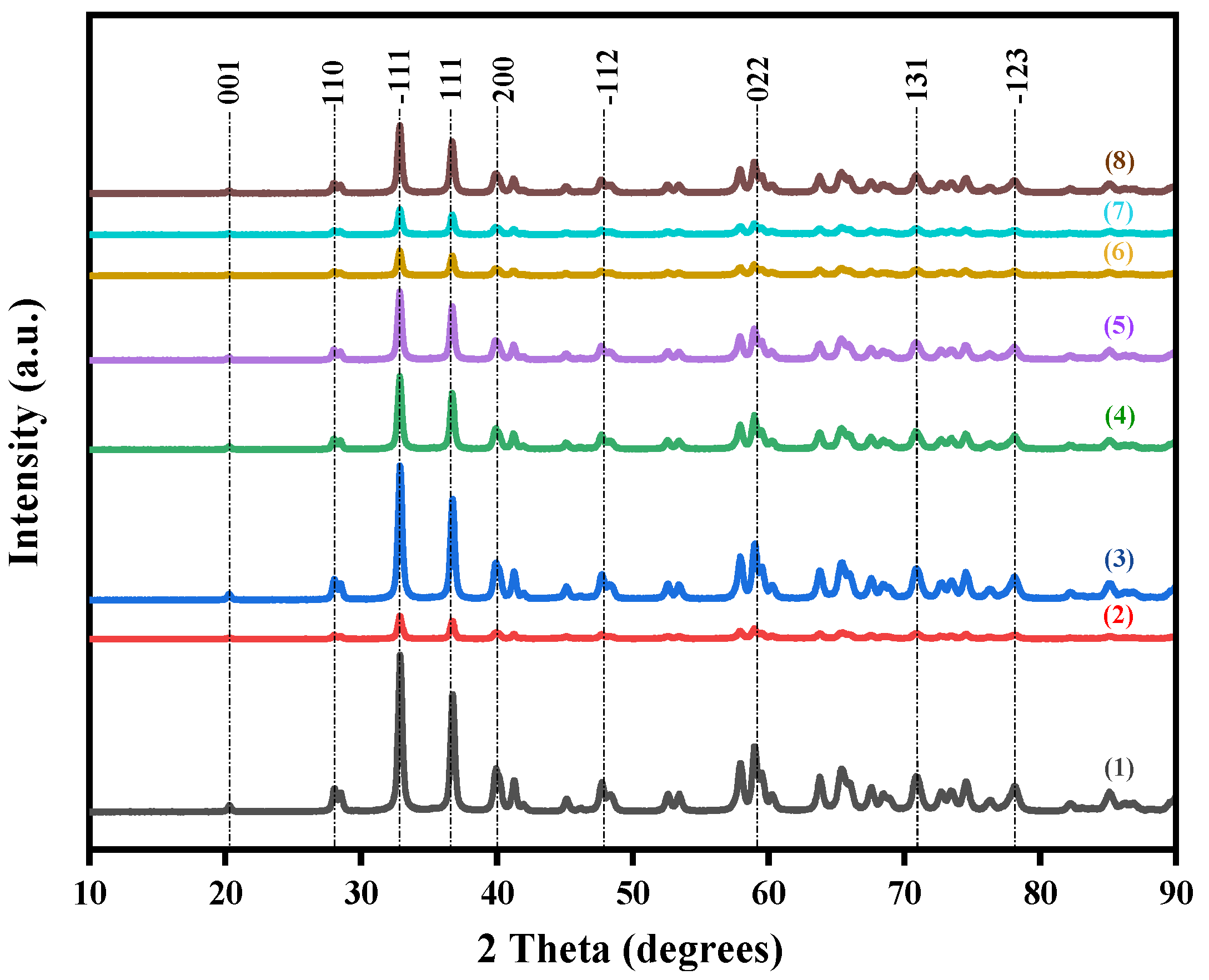
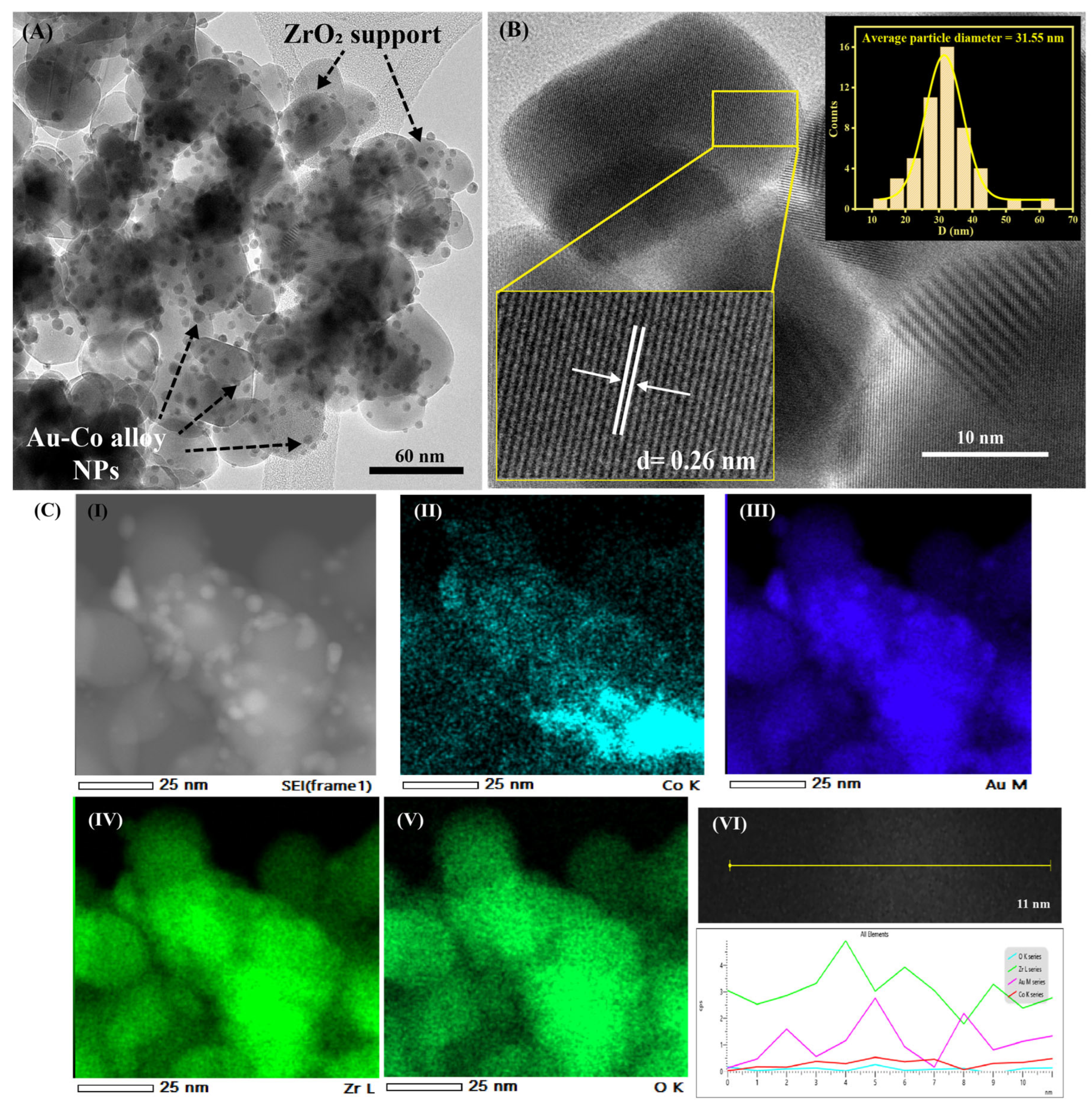
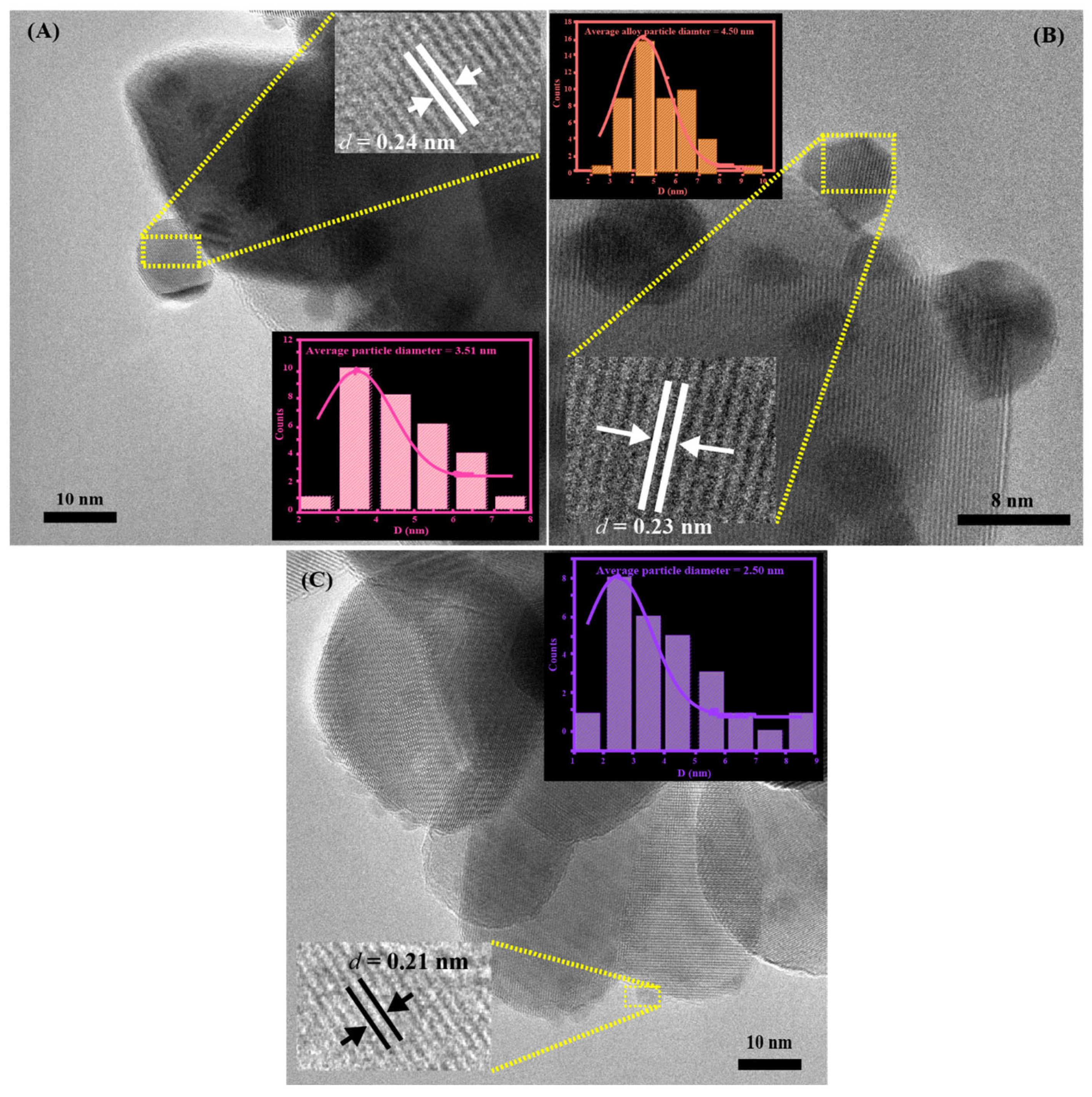



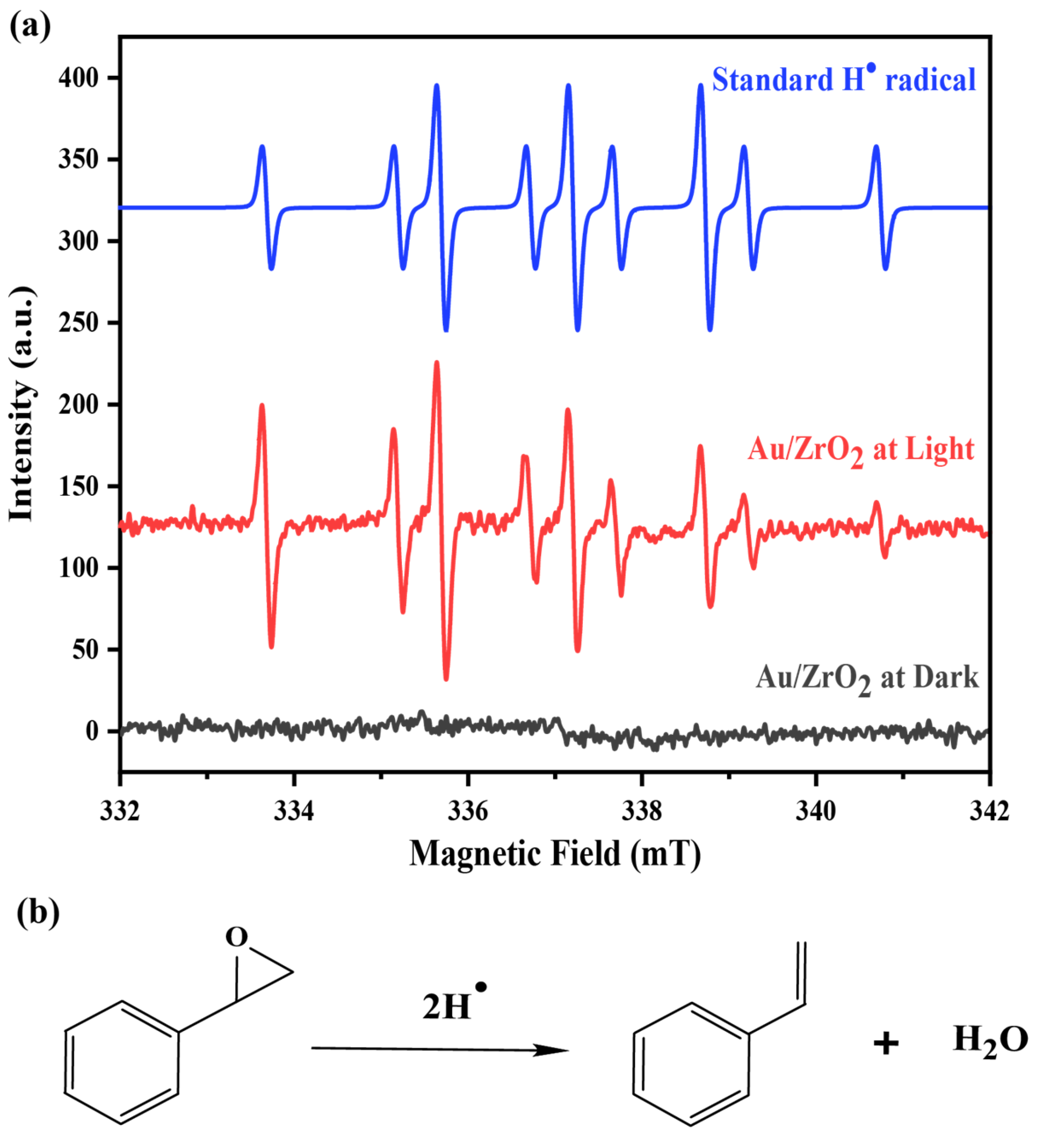
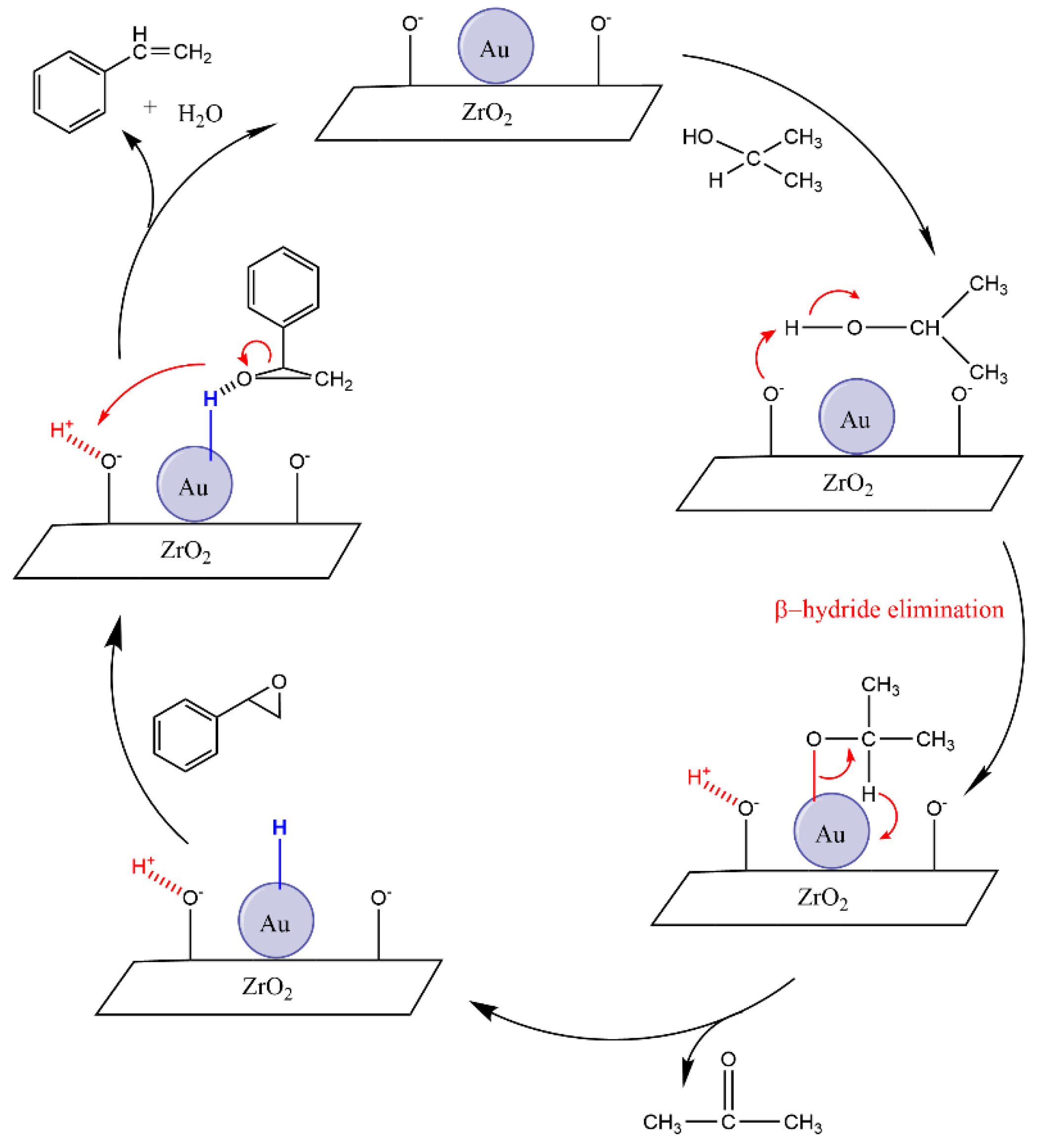
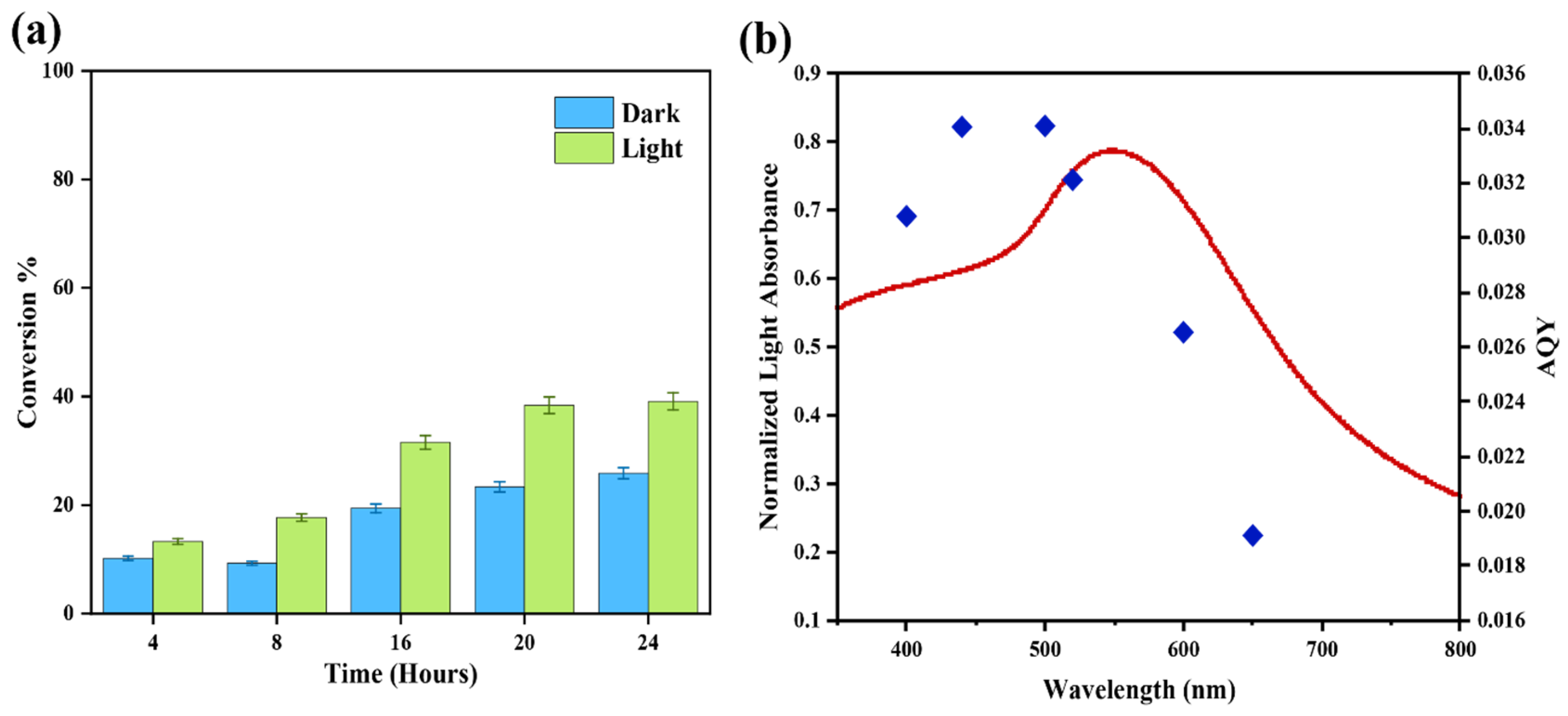
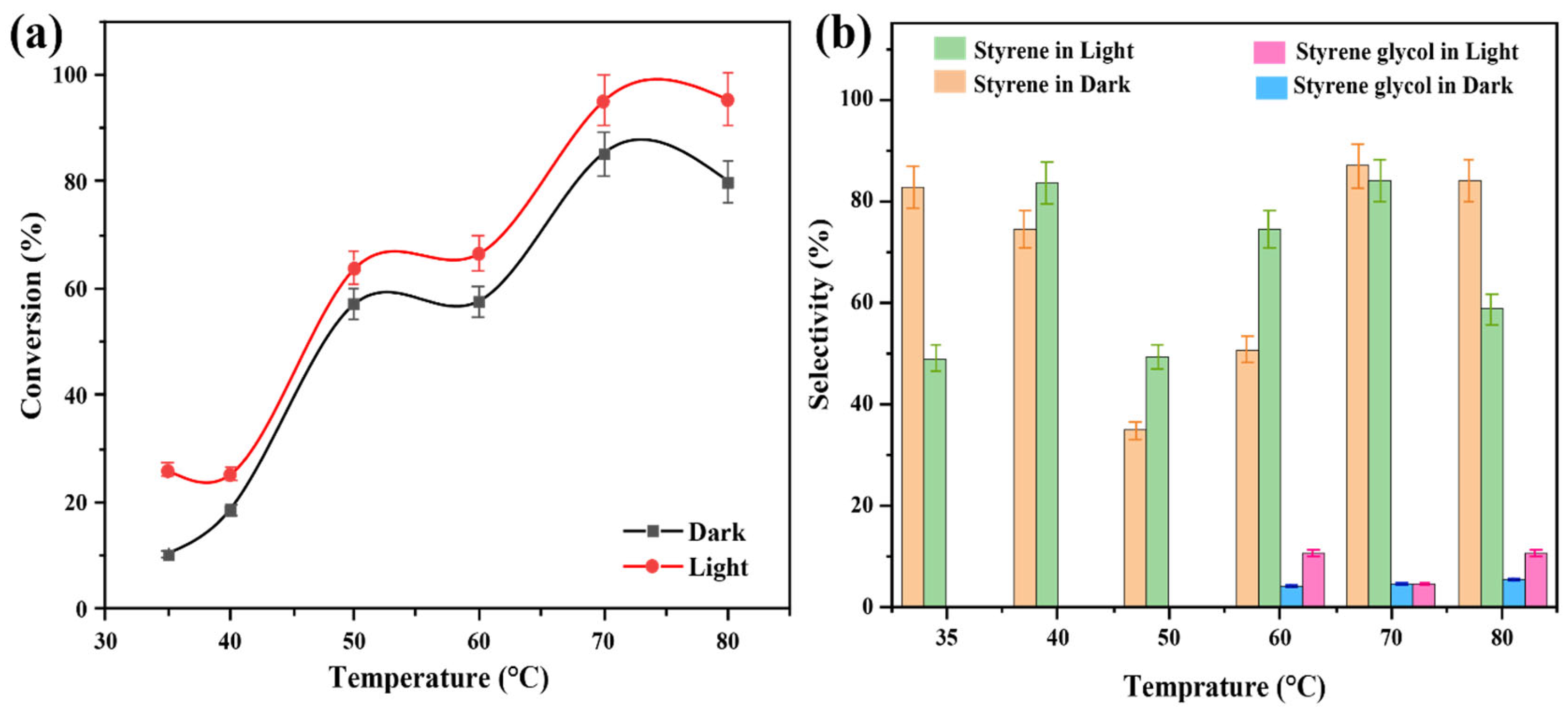

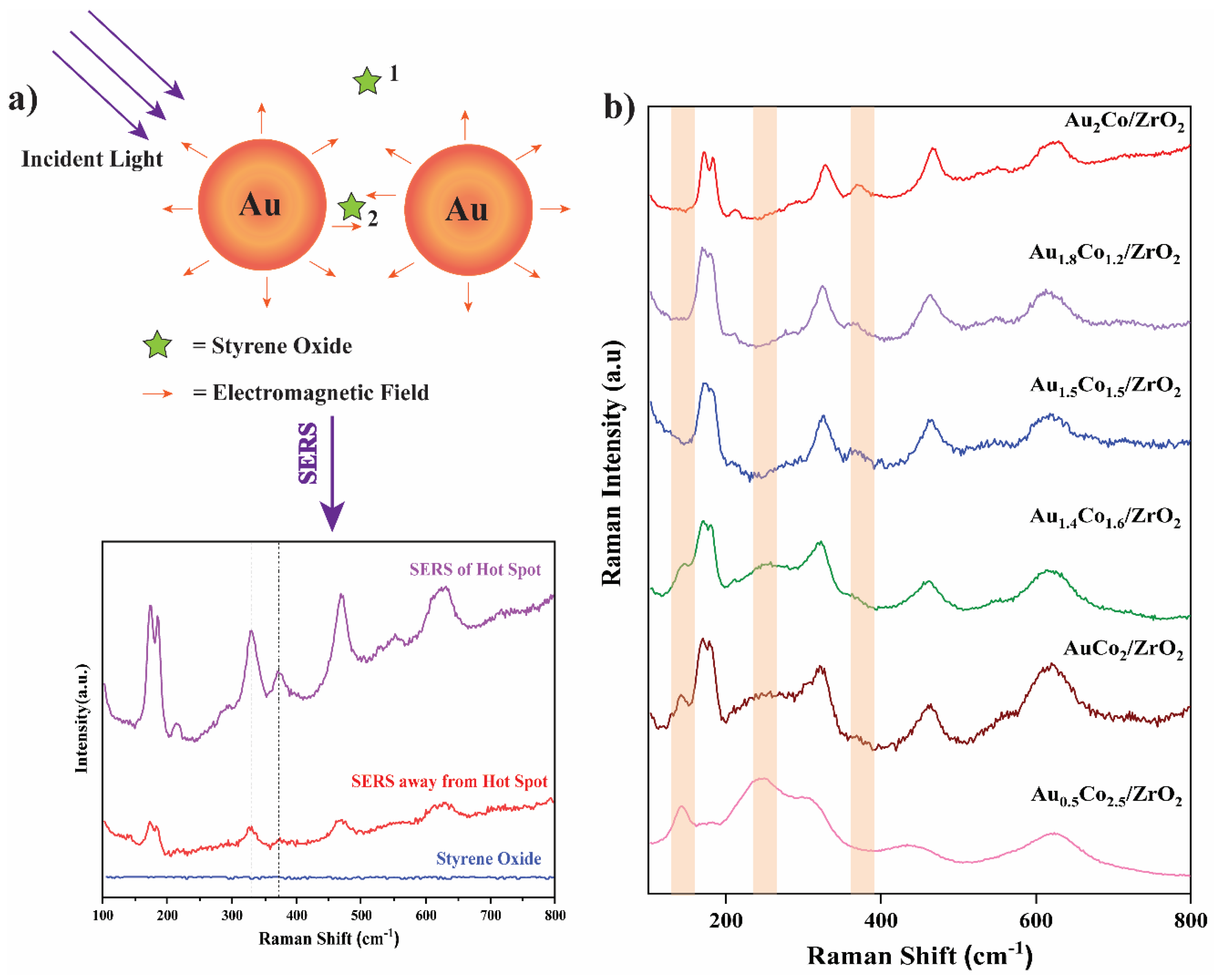
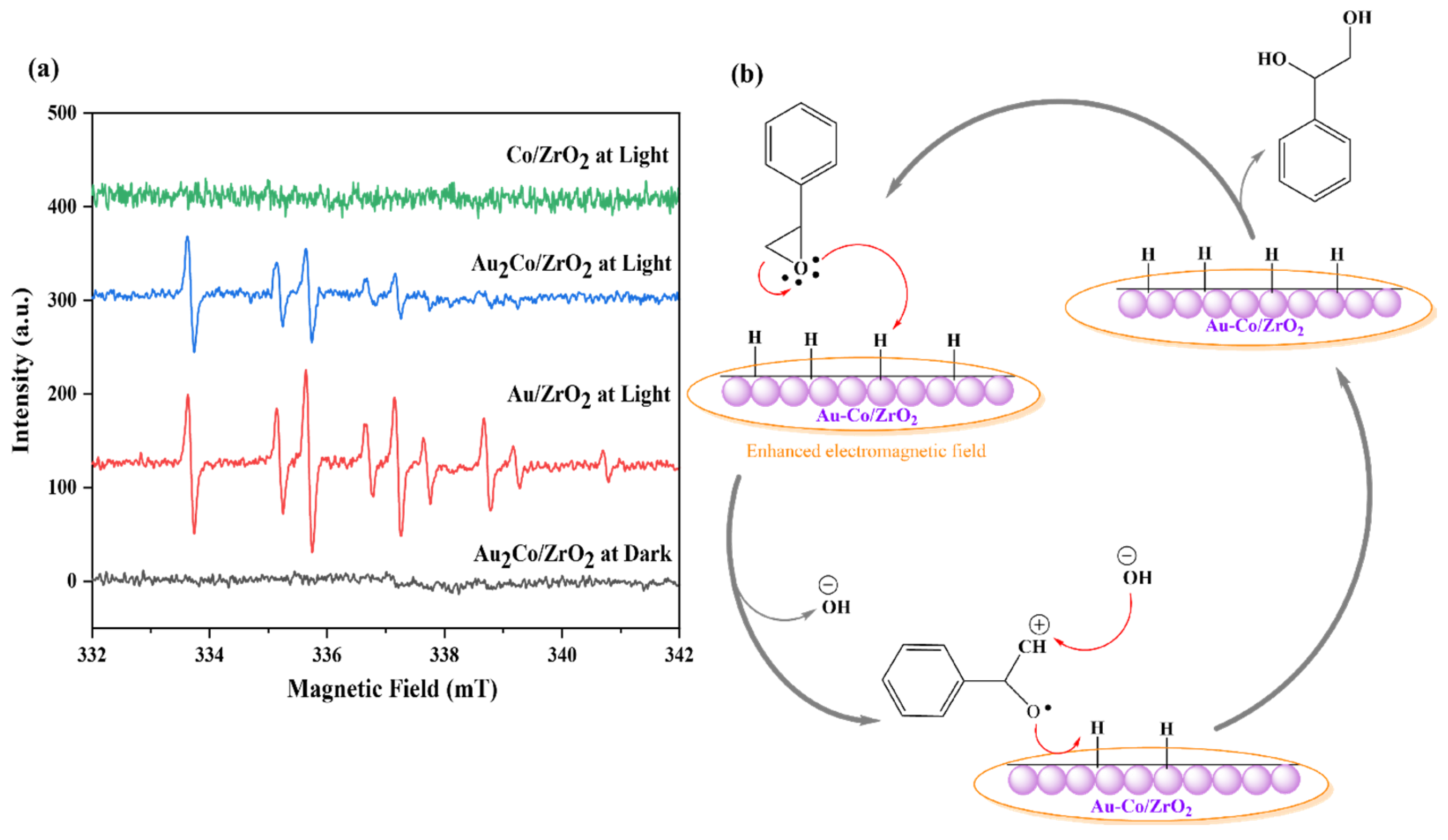
Disclaimer/Publisher’s Note: The statements, opinions and data contained in all publications are solely those of the individual author(s) and contributor(s) and not of MDPI and/or the editor(s). MDPI and/or the editor(s) disclaim responsibility for any injury to people or property resulting from any ideas, methods, instructions or products referred to in the content. |
© 2025 by the authors. Licensee MDPI, Basel, Switzerland. This article is an open access article distributed under the terms and conditions of the Creative Commons Attribution (CC BY) license (https://creativecommons.org/licenses/by/4.0/).
Share and Cite
Abeyrathna, H.T.; Fernando Thibiripalage, C.L.; Zhu, H.Y.; Waclawik, E.R. Au-Co Alloy Nanoparticles Supported on ZrO2 as an Efficient Photocatalyst for the Deoxygenation of Styrene Oxide. Nanomaterials 2025, 15, 957. https://doi.org/10.3390/nano15130957
Abeyrathna HT, Fernando Thibiripalage CL, Zhu HY, Waclawik ER. Au-Co Alloy Nanoparticles Supported on ZrO2 as an Efficient Photocatalyst for the Deoxygenation of Styrene Oxide. Nanomaterials. 2025; 15(13):957. https://doi.org/10.3390/nano15130957
Chicago/Turabian StyleAbeyrathna, Hashini T., Chamodi L. Fernando Thibiripalage, Huai Yong Zhu, and Eric R. Waclawik. 2025. "Au-Co Alloy Nanoparticles Supported on ZrO2 as an Efficient Photocatalyst for the Deoxygenation of Styrene Oxide" Nanomaterials 15, no. 13: 957. https://doi.org/10.3390/nano15130957
APA StyleAbeyrathna, H. T., Fernando Thibiripalage, C. L., Zhu, H. Y., & Waclawik, E. R. (2025). Au-Co Alloy Nanoparticles Supported on ZrO2 as an Efficient Photocatalyst for the Deoxygenation of Styrene Oxide. Nanomaterials, 15(13), 957. https://doi.org/10.3390/nano15130957









